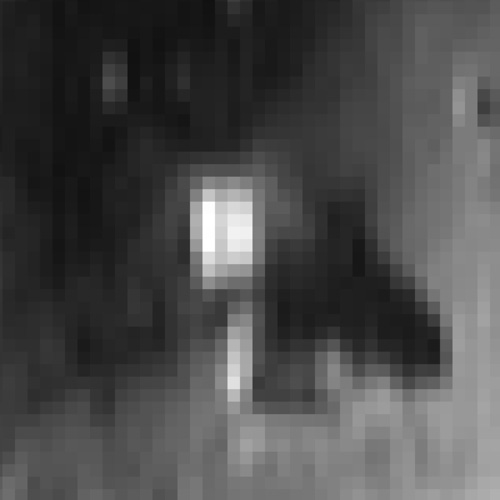- Jeff,
-
- Hi, you may add this to the article if you like:
-
- The image blow up in the page on the Eros boulder has
been subjected to bicubic interpolation, that is, in the enlargement process
a blurring and smoothing algorythm has been applied to the data. While
this is good for artistic and some interpretive purposes, it does distort
the data to a degree that the source material must be used as a reference
for any "scientific" analysis of the image.
-
- When resizing images for analysis in Photoshop, one should
go into the preferences section and turn off the bicubic resampling option.
The nearest neighbor option yields the more accurate result.
-
- Enclosed is a blowup in the jpg format (with best image
quality) of both a straight and bicubic version and a Phoptoshop .PSD containing
both layers.
-
- For anyone attempting to do analysis of the other image
on this page they should keep in mind that it contains jpeg artifacting
grids and they should use the image at the NEAR site.
-
- Rupert Chappelle
-
-
-

-
-
- From: Brian Cuthbertson
- To: webmaster@sightings.com
- Subject: Rectangular Boulder on Eros?
-
- Take a good long look at the "rectangular boulder"
referenced in the post below to the lunascan email list. Boulder ?? (BTW,
I don't pretend to speak for Jim; I just subscribe to the lunascan list.)
-
- -Brian Cuthbertson
-
-
- From: "Jim Moore"
- Subject: RE: [lunascan] Near Earth Asteroid Eros/R.C.Hoagland
-
- I'm holding in my hand a photo of image 0132577092 taken
from the NASA site. The object in the upper right hand corner sure looks
artificial to me! NASA says its a "rectangular boulder". I'm
not joking, that's what they say!
-
- See the picture at;
- http://near.jhuapl.edu/iod/20000503/
-
- From Near Earth Asteroid Renezvous Mission website:
The View from Low Orbit
-
- This image of Eros, taken from the NEAR Shoemaker spacecraft
on May 1, 2000, is among the first to be returned from "low orbit."
Between May and August, the spacecraft will orbit at altitudes near 50
kilometers (31 miles) or less. This will be the prime period of activity
for some of the spacecraft's science instruments. The X-ray / gamma-ray
spectrometer will build up maps of chemical abundances, while the laser
rangefinder measures the shape of Eros to within meters (a few feet). At
the same time the magnetometer will watch for indications of Eros' magnetic
field and the near-infrared spectrometer will map rock types.
-
- The imager will take pictures of the entire surface of
Eros that capture features as small as 4 meters (13 feet) across. This
particular image, taken from an orbital altitude of 53 kilometers (33 miles),
shows a scene about 1.8 kilometers (1.1 miles) across. Numerous craters
and boulders as small as 8 meters (26 feet) across dot the landscape. The
large, rectangular boulder at the upper right is 45 meters (148 feet) across.
|



